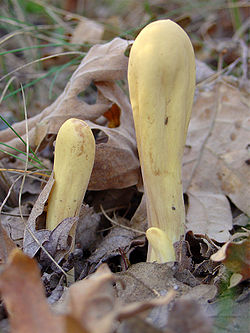| Clavariadelphus | |
|---|---|
 | |
| Clavariadelphus pistillaris | |
| Scientific classification | |
| Domain: | Eukaryota |
| Kingdom: | Fungi |
| Division: | Basidiomycota |
| Class: | Agaricomycetes |
| Order: | Gomphales |
| Family: | Clavariadelphaceae |
| Genus: | Clavariadelphus Donk (1933) |
| Type species | |
| Clavariadelphus pistillaris (L.) Donk (1933) | |
| Species | |
19 species | |
Clavariadelphus is a genus of club fungi in the family Clavariadelphaceae. The genus has a widespread distribution in temperate areas, and contains an estimated 19 species. [1] The name might mean uterus-shaped club, from the Latin clava meaning club and the Greek delphus meaning uterus.